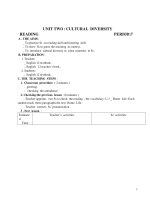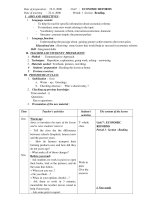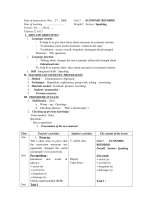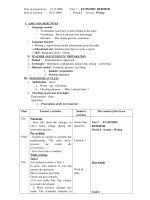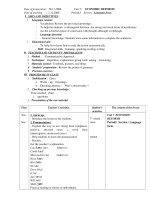shape of grammar lesson plan (word)
Bạn đang xem bản rút gọn của tài liệu. Xem và tải ngay bản đầy đủ của tài liệu tại đây (242.23 KB, 13 trang )
Grammar lesson plan structure
Content
Warm up....................................................................................................................2
Presentation stage......................................................................................................4
Practice stage.............................................................................................................8
Production stage......................................................................................................11
1
Warm Up
1.1.
New words
1.2.
New structure
Home work
2.1.
Drills
or Controlled
practice
2.2.
Less controlled
practice
3.1.
Free controlled
practice
Grammar
lesson
plan
1.
Presentation
2.
Practice
3.
Production
Grammar lesson plan structure
Warm up
1. Definition
Short, easily activities which teacher uses at the beginning of the lesson to wake up
students.
2. Why warm-up activities are necessary for the lesson?
A warm-up activity is very necessary for the following reasons:
- With new classes at the beginning of the course or the school year, it can help
students to know each other. Once they have talked to each other, they will be
less reluctant to co-operate in further activities.
- If the teacher join in the activities and let the class know something about
himself/ herself. The students are more likely to accept him/ her as a person and
not just as a teacher.
- It wakes up the students and gets them into the right mood for learning English.
- It can be brief vocabulary review before starting a new text.
- It can be a link between what has gone before and what is coming.
Most of the warming-up activities are suitable for beginners because they don’t
demand more than simple questions and answers. But the language content of the
activities can easily be adapted to higher level of proficiency. The teacher are probably
the best judge of the appropriate of an activity for their students.
3. Kinds of activities
There are many kinds of activities and the teacher need to choose the right ones:
- Vocabulary activities: Slap the board, what and where, network, kim’s game,
hangman, brain storming…
- Grammar activities: Pelmanism, guessing game, interview, crosswords, tick-tac-
toe, lucky number, knock out…
- Skills activities: Three adj/clusters, don’t say yes or no, evidence, express your view..
- Mixed activities: Find someone who, survey…
4. How to use warm-up activities effectively?
Which activities should be used, it depends on your purpose/ the lesson or many
factors:
- The size of the class
- Whether it is a class of adults or one of children.
- The class level – elementary, pre-intermediate…
- the structures being studied at the moment.
- The noise factors – will you disturb the classes around you?
- The students’ interest.
2
Grammar lesson plan structure
- The equipment and material available.
- The time available for an activity.
5. What should the teacher do?
Once you have found a suitable activity for your class, you should do the following:
- Prepare your materials in sufficient quantity.
- Read through the process of the activity and if it’s necessary, note down the
main steps.
- Think about how you are going to introduce the activity and whether your
students will need any extra help.
- Decide which role you are going to adopt (joining, helping or observing?) and
stick to it throughout the activity.
- Make a note of any problems arising as well as your own comments and those
of your students. You can then modify the activity when you use it again.
NOTE: Warming up activities may seem threatening to very shy students when one
person has to speak about himself in front of the whole class. You can reduce the strain
by re-organizing the activity in such a way that the student concerned is questioned by
the class thus avoiding a monologue where the pressure is on one person only. Students
often find pair works the least threatening because everybody is talking at the same
time and they have only got one listener. Depending on the atmosphere in your classes,
you may wish to modify whole class activities to include pair or group work.
3
Grammar lesson plan structure
Pre sen t ati o n st age
a. Presenting vocabulary
I. Definition
Vocabulary of a language is all its words, compounds and idioms used to convey and
receive information in oral and written communication
II. Kinds of vocabulary
*Active vocab: The words can understand, pronounce correctly, use effectively in
speaking and writing.
*Passive vocab: The words can recognize and understand in the context.
III. Some techniques for presenting a new word
1. Visuals
- Objects
- Pictures
- Drawings
- Charts, maps, diagrams…
2. Mime
Use your actions, body language.
3. Realia
- Real objects
- Real people
- Real things
4. Example
Use the new word in different contexts
5. Explanation/ Situation
Teacher gives a detailed description of the new word to make Ss imagine the meaning
6. Synonym/ Anonym
Words with the same or opposite meaning to the new word.
7. Translation
- What does this mean in Vienamese?
- How do you say it in Vietnamese?
IV. How to teach a new word?
Presenting a new word need:
- Spoken form → pronounce → written form
- Present in meaningful contexts
- Check is essential.
4
Grammar lesson plan structure
* Steps for presenting a new word
1. Eliciting
Teacher elicits the meaning of the word by using one of 7 above techniques.
2. Models
Teacher models (pronouces) 2 or 3 times.
3. Choral repetition
Students repeat chorally
4. Individual repetition
Students repeat individually (some students)
5. Teacher corrects mistakes (if necessary)
6. Teacher writes the word on the board
7. Teacher checks understanding/ mean/ stress…
IV. Guidelines for presenting new vocabulary effectively
- Teacher elicits the words for different parts of the face. Try to elicits each word:
point to the feature on your face, ask teacher called, how to spell it.
- Eliciting involves the class by focusing students’ attention. This happen even if
students don’t know the word being elicited.
- Eliciting encourages students to draw on what they already know and don’t
know.
- Eliciting gives teachers a chance to see what students know or don’t know.
- Teacher would not try to elicit all the time.
V. Do we present all vocabulary in the same way?
- I think the teacher should present all vocabulary in many different ways.
It makes students enjoy and understand new words more and more.
- If the teacher presents all vocabulary in the same way, it doesn’t bring
effectively because students will feel boring and tired.
- Each word has different meaning.
a. Presenting New structure
What activities do you use to present new language?
- Dialogue Build
- Rub Out and Remember
- Picture story
- Pictures
- Examples and grammatical explanation
- …
5
